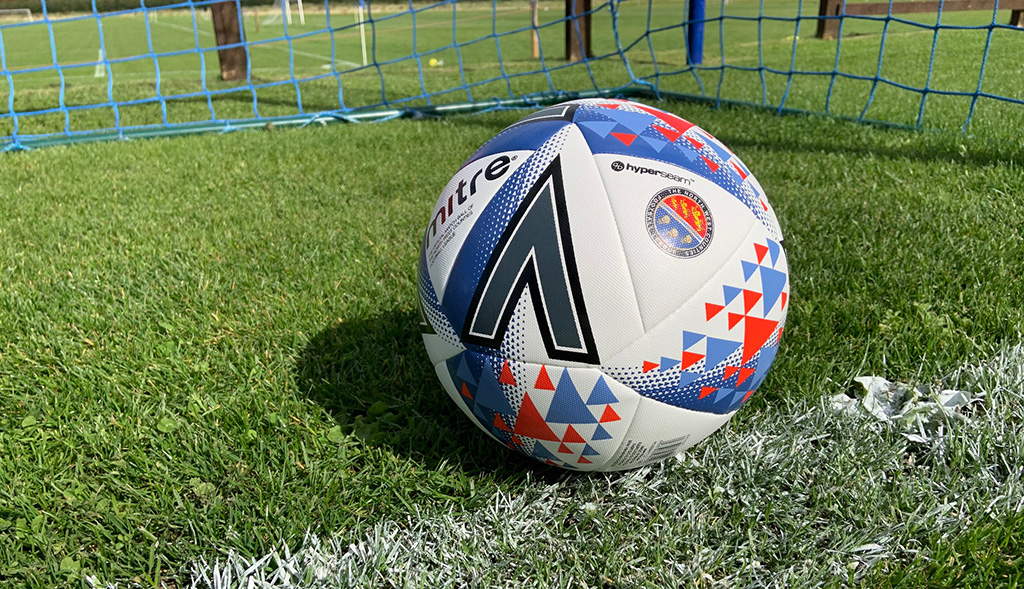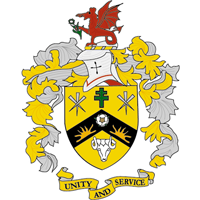
Emblematically Speaking - Silsden
Sun 3rd September 2017 | Silsden | By Stewart Taylor
Careful study of this club emblem is most rewarding, in that the amount of information contained in a single image is huge.
The emblem is the coat of arms of Silsden, which has its origins in the Borough Arms of Keighley which was granted by the Herald’s College on 7 February 1883.
The variation for Silsden was officially granted on 6 October 1954, following an application by the town council to commemorate the coronation of Queen Elizabeth II in 1953.
The shield (arms) contains a chevron which comes from the arms of the Jennings family, who held the Manor of Silsden as early as 1487. Land was purchased from the Jennings family, for the then princely sum of 10 shillings, to construct a church. This is the Parish Church of Silsden, St James, which lies on Kirkgate in the centre of the town.
The double cross denotes the town's connections with the Knights of St. John of Jerusalem, who held lands at Silsden previously in the possession of the Knights Templar. It is coloured green to represent land.
The three shoe-nails or "sparrow-bills" on each side of the cross, recall the nail-making industry which was brought to Silsden by William West in 1744. The importance of this industry to the town was reflected in 2011 by a representation of a rusty nail by the Egyptian born sculptor Sam Shendi, which was erected on Kirkgate.
The ram's head at the bottom of the shield typifies both the woollen industry, which played such a large part in the history of Silsden, and the farming industry of the outlying districts.
The white rose refers to Yorkshire and the sun's rays, either side of the Yorkshire Rose, were adopted to represent the rayon industry. The town of Silsden holds an important place in the history of rayon - man made silk – in that the town was universally recognised as being the centre of the rayon fabric manufacturing industry.
The crest features a red wyvern which is adapted from the arms of the Clifford family of Skipton Castle, Earls of Cumberland and ancient lords of the Honor of Skipton in which Silsden was an important manor. This important feature shows a major distinction from the coat of arms of Keighley in that a dragon appears in this place on the crest of the latter.
The flax flower, held in the claw of the wyvern denotes the ancient flax-growing industry of Silsden Moor in the 18th century to meet the demand for cordage and sail for the rapidly expanding Royal Navy.
The wyvern sits atop a closed and tilting helm representing English squires and gentlemen.
The motto “Unity and Service” is self explanatory.
So there we have it, a potted history of the town of Silsden in pictorial form. We said in the introduction to this series that a picture is worth a thousand words. This article is somewhat less than 1000 words but, believe me, it could have been an awful lot more.
Silsden AFC in gold on a red scroll was added in 2016.
It is of interest to note that Silsden AFC have incorporated elements of both the Keighley and Silsden coats of arms into the names of their Junior football sides – Knights, Dragons and Rams.
(with thanks to John Barclay of Silsden AFC for his help in compiling this article)
 Emblematically Speaking - Silsden
Emblematically Speaking - Silsden
Sun 3rd September 2017 | Silsden
By Stewart Taylor

Careful study of this club emblem is most rewarding, in that the amount of information contained in a single image is huge.
The emblem is the coat of arms of Silsden, which has its origins in the Borough Arms of Keighley which was granted by the Herald’s College on 7 February 1883.
The variation for Silsden was officially granted on 6 October 1954, following an application by the town council to commemorate the coronation of Queen Elizabeth II in 1953.
The shield (arms) contains a chevron which comes from the arms of the Jennings family, who held the Manor of Silsden as early as 1487. Land was purchased from the Jennings family, for the then princely sum of 10 shillings, to construct a church. This is the Parish Church of Silsden, St James, which lies on Kirkgate in the centre of the town.
The double cross denotes the town's connections with the Knights of St. John of Jerusalem, who held lands at Silsden previously in the possession of the Knights Templar. It is coloured green to represent land.
The three shoe-nails or "sparrow-bills" on each side of the cross, recall the nail-making industry which was brought to Silsden by William West in 1744. The importance of this industry to the town was reflected in 2011 by a representation of a rusty nail by the Egyptian born sculptor Sam Shendi, which was erected on Kirkgate.
The ram's head at the bottom of the shield typifies both the woollen industry, which played such a large part in the history of Silsden, and the farming industry of the outlying districts.
The white rose refers to Yorkshire and the sun's rays, either side of the Yorkshire Rose, were adopted to represent the rayon industry. The town of Silsden holds an important place in the history of rayon - man made silk – in that the town was universally recognised as being the centre of the rayon fabric manufacturing industry.
The crest features a red wyvern which is adapted from the arms of the Clifford family of Skipton Castle, Earls of Cumberland and ancient lords of the Honor of Skipton in which Silsden was an important manor. This important feature shows a major distinction from the coat of arms of Keighley in that a dragon appears in this place on the crest of the latter.
The flax flower, held in the claw of the wyvern denotes the ancient flax-growing industry of Silsden Moor in the 18th century to meet the demand for cordage and sail for the rapidly expanding Royal Navy.
The wyvern sits atop a closed and tilting helm representing English squires and gentlemen.
The motto “Unity and Service” is self explanatory.
So there we have it, a potted history of the town of Silsden in pictorial form. We said in the introduction to this series that a picture is worth a thousand words. This article is somewhat less than 1000 words but, believe me, it could have been an awful lot more.
Silsden AFC in gold on a red scroll was added in 2016.
It is of interest to note that Silsden AFC have incorporated elements of both the Keighley and Silsden coats of arms into the names of their Junior football sides – Knights, Dragons and Rams.
(with thanks to John Barclay of Silsden AFC for his help in compiling this article)


